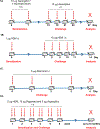Modeling Asthma in Mice Using Common Aeroallergens
- PMID: 35771460
- PMCID: PMC9721467
- DOI: 10.1007/978-1-0716-2364-0_1
Modeling Asthma in Mice Using Common Aeroallergens
Abstract
Aeroallergens are common inducers of asthma in humans and are widely used in experimental research to generate animal models of this disease. In this chapter, we describe four mouse models of aeroallergen-induced asthma. These models differ in type and number of allergens used, route and duration of allergen exposure, and utilization of an adjuvant, representing different mechanistic variants of asthma. In addition, we describe several basic methods that are commonly used in mechanistic studies of asthma in mice. These methods include tracheotomy and bronchoalveolar lavage, cytospin and morphologic analysis of bronchoalveolar lavage cells, and lung harvest and digestion for generation of single-cell suspension.
Keywords: Aeroallergen; Airway hyperresponsiveness; Asthma; Bronchoalveolar lavage; Inflammation; Mouse model; Sensitization.
© 2022. The Author(s), under exclusive license to Springer Science+Business Media, LLC, part of Springer Nature.
Figures


References
-
- Wenzel SE (2006) Asthma: defining of the persistent adult phenotypes. Lancet 368:804–813 - PubMed
-
- Sporik R, Holgate ST, Platts-Mills TA et al. (1990) Exposure to house-dust mite allergen (Der p I) and the development of asthma in childhood. A prospective study. N Engl J Med 323:502–507 - PubMed
-
- Illi S, von Mutius E, Lau S et al. (2006) Perennial allergen sensitisation early in life and chronic asthma in children: a birth cohort study. Lancet 368:763–770 - PubMed
-
- Langley SJ, Goldthorpe S, Craven M et al. (2003) Exposure and sensitization to indoor allergens: association with lung function, bronchial reactivity, and exhaled nitric oxide measures in asthma. J Allergy Clin Immunol 112:362–368 - PubMed
Publication types
MeSH terms
Substances
Grants and funding
LinkOut - more resources
Full Text Sources
Medical

